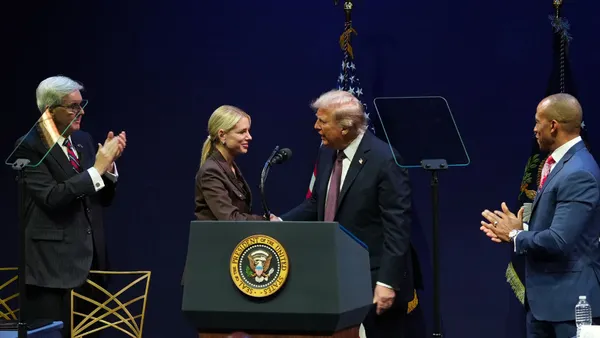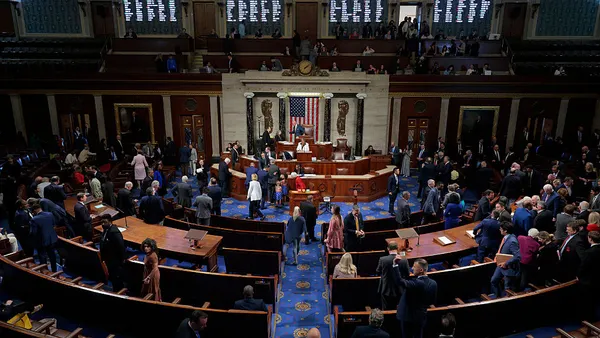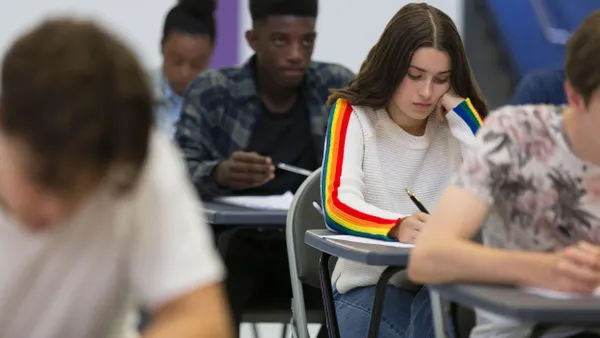Dive Brief:
- A letter signed by nearly 700 school district leaders to U.S. Education Secretary Miguel Cardona on Monday requests that the Education Department expedite guidance regarding extension deadlines for federal Elementary and Secondary School Emergency Relief funding.
- The Education Department had said in May that it was allowing an 18-month liquidation extension, but school district leaders and school administration organizations said they need more guidance about how to apply for the extensions.
- The district leaders said that without clarity, it will be difficult to plan for the "efficient and effective" use of billions of dollars in funds, which have been essential in paying for pandemic-related learning recovery programs, building upgrades, mental health supports and more.
Dive Insight:
The district leaders' letter focuses on the liquidation — or spending — deadline for $121.9 billion for pre-K-12 in the American Rescue Plan, also known as ESSER III. Districts would still need to obligate — or commit to spending — those funds by the Sept. 30, 2024, deadline, but the extension deadline could allow them to draw down those funds until March 31, 2026.
The obligation deadlines for ESSER I and ESSER II are Sept. 30, 2022, and Sept 30, 2023, respectively, although it is unclear if the 18-month extension only applies to ESSER III spending. In total, ESSER funding equals $189.5 billion.
"The sooner we know whether a liquidation extension can be granted, the better we can plan for the most effective and efficient use of ESSER funds," the letter to Cardona said.
Nick Polyak, superintendent of Leyden High School District 212 in Illinois, was one of the letter signers. He said in an email that his district has plans to make HVAC upgrades with its ESSER funds but is facing a nearly year-long delay in getting equipment. Many other districts are likewise ordering HVAC equipment, he said.
"The industry, by no fault of their own, cannot keep up with the demand," Polyak said.
A July 22 letter to Cardona from national education advocacy and service organizations, referenced in Monday's letter from district leaders, specifically sought clarification about:
- If the 18-month extension applies to ESSER I and ESSER II funding, in addition to ESSER III.
- Whether the Education Department would consider a streamlined application process where states could make a blanket request for extensions for all districts in the state, rather than on a case-by-case basis.
- If extensions for ESSER III liquidation activity could push beyond March 31, 2026, to Dec. 31, 2026, so funding would be available for the entire 2025-26 school year.
The groups also asked the Education Department to confirm that extensions would be considered not only for school infrastructure projects but also for other COVID-19 recovery activities, such as tutoring supports and summer school programming.
An Education Department spokesperson said in an email to K-12 Dive on Tuesday, "We’ve received AASA’s letter and look forward to responding to them directly."
Sasha Pudelski, director of advocacy at AASA, The School Superintendents Association, said Education Department officials have told the organization they are crafting guidance. But with the ESSER I obligation deadline of Sept. 30 fast approaching, the guidance can't come soon enough, she said.
When Congress first appropriated COVID-19 emergency relief for schools in March 2020, it was not known then how long the pandemic would impact schools. Now, 2 ½ years later, there's still a significant need for the federal funds, Pudelski said.
"There is definitely going to be a need for extended recovery, academic and social-emotional recovery efforts in schools," she said.
In January, AASA and 31 other education, health, environmental, labor and industry organizations, requested flexibility with the spending deadline. At the time, the groups said it would be “nearly impossible” for districts to meet the deadline given the logistical and staffing challenges.
When asked Tuesday if any district or state has made a liquidation extension request, Pudelski said, "You can't apply because there's no process for applying."
Pudelski said that if a district has unspent funds by the liquidation deadline, those monies will be returned to the federal government.














